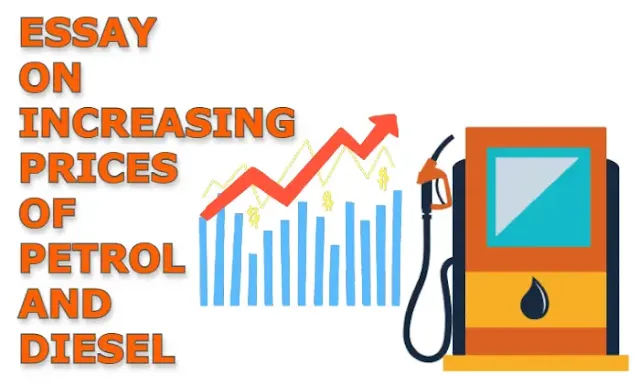Essay on increasing price of petrol and diesel
With crude oil prices recovering to peak over levels, consumers around the world are paying more for petrol and diesel, but Indian consumers, in particular, are paying more than others because of the high incidence of certain excise duties and state taxes.
why Indian consumers paying more than before?
Indians have been paying more for petrol and diesel, especially over the past couple of months, and we've seen a number of hikes in the price of petrol and diesel. The immediate cause for this, as the government has been saying is an increase in international crude oil prices.
But the larger impact on fuel prices is due to hikes in central and state taxes on petrol and diesel over during 2020. the sector particularly raised taxes on petrol by 30rs/ liter and diesel by 16rs/liter. this has by far the largest impact on places today. They've been hitting record highs already in January and they continue to go up to.
why are prices increasing now and why the increasing every single day?
For that, we need to understand how this pricing is done india import of 80 % of its crude oil requirements and fluctuations in prices globally would impact us. you'd think that since the prices reducing drastically due to lower demand during the pandemic, the price of fuel on the country would actually go down, but not in India? It's not that simple. And for that we need to understand all the components that make up the price of one leader of all of these in India.
First, there's the price of the crude oil and the cost to transport it. Then it includes the cost paid by oil marketing companies known as OMC to a refinery to refine the crude oil. Add to this the margin that the OMC takes and the commission that the dealer that is the petrol pump owner takes. Then add to this the excise duties and the taxes levied by the state.
why is crude oil pricing rising now?
International crude oil prices took a major hit due to the covid- pandemic. Brent crude, in particular, came down to below 20 dollars, due to lower demand due to the pandemic and a number of countries imposing travel restrictions slowing down their economies.
but in July, prices came to around forty dollars and stayed around that level in October. Since then, however, we've seen a steady increase in the price of crude oil from 40 to now over 60 dollars a barrel and this has been due to a number of factors, including optimism about the vaccine as the rollout goes on.
We are seeing expectations from both countries that the demand for petrol and diesel and all fuels will go up. Besides this, oil-producing countries have been very disciplined with their production.
They have maintained in many cases the cuts that they had made during the pandemic. The price is somewhat elevated. In fact, Saudi Arabia even announced that they would be cutting their daily production of crude oil by one million barrels per day through February and March to keep prices elevated. So these are the key reasons why we're seeing the price of crude oil go up now.
How are the taxes impacted on retail fuel prices?
what we're seeing now is that Beck says that, in fact, the largest component of our fuel prices across major cities, if we take the example of Delhi, the price of petrol for example, from the refinery gate to the dealer is only around 32 rs/liter. But the price of the other taxes, the excise duty alone itself is about 33rs/liter more than the actual price.
Besides, this consumer are also paying the state tax-VAT, which is another Rs20.5/liter. This leads to us seeing taxes accounted for in the case of petrol in delhi around 170% of the base price of petrol, and this is mirrored across a number of cities in Mumbai the incidence of tax is higher from the state level, leading to even higher prices.
How does this situation compare with other countries?
So tax account for about 60 % of the pump prices of petrol, in particular in Delhi right now. this is largely comparable to some extremely developed economies like Germany and Italy, where they account for about 65% to 62% but are significantly higher than taxes in countries like Japan, where taxes that are 45% and taxes in the US where they are around 20% of the pump price.
How has the tax revenue from petroleum products change over the years?
Tax revenues from the sale of petrol and diesel are a key part of receipts for both the center and the states. looking at the central receiptsenue the actual tax revenue from the sale of petroleum diesel was about 2.2 trillion rupees in FY 2020 and it was budgeted about 2.48 trillion rupees in FY2021.
But due to the pandemic, the government raised taxes and it went up to around 3.46 trillion rupees and this is expected to go up slightly even further to 3.7 trillion rupees.
So that would make it over a 50% hike. If you're looking at budget estimates for the previous fiscal to this fiscal. the government is increasingly depending on petrol and diesel to make up for shortfalls across taxes, particularly in GST and other indirect taxes.
All of this only two parties are happy. The centre and state governments, both of which are starved of revenue and make money on every liter of petrol and diesel sold.
Also read: Essay on environmental pollution
Also read: Essay on pollution
Also read: Essay on depletion of natural resources
Also read: How to keep the environment clean essay
THANK YOU SO MUCH

I am very much pleased with the contents you have mentioned. I wanted to thank you for this great article. Petrol in diesel uk
ReplyDelete